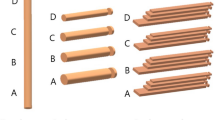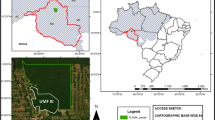Abstract
Although Papua New Guinea (PNG) has a rich and diverse forest cover, there is limited information on processing characteristics for plantations and regrowth forests available. Consequently, the PNG timber processing industry is restricted to a few species, producing low-quality products, which limits opportunities for the processors. Sound knowledge of machining characteristics based on some systematic methods has been identified as essential for assessing the ability in processing raw material into appearance products. Therefore, a testing program was conducted to assess the planing characteristics and most common causes for planing degrade of 25 species sourced from the Morobe and West New Britain provinces, PNG. A total of 18 wood species proved to machine very well with more than 90% of assessed boards being graded either “excellent and requiring very light sanding” or “good and requiring light sanding”. Eight species from this group obtained a perfect score, i.e. requiring very light sanding.

Similar content being viewed by others
Reference list
Aknouche H, Outahyon A, Nouveau C, Marchal R, Zerizer A, Butaud J-C (2009) Tool wear effect on cutting forces: in routing process of aleppo pine wood. J Mater Process Tech 209:2918–2922
Asdar M (2010) Machining properties of Surian (Toona sinensis) and Kepayang (Pangium edule) woods. J Penelit Hasil Hutan 28(1):18–28
ASTM (2010) Standard Practice for Sampling Forest Trees for Determination of Clear Wood Properties. ASTM D5536. ASTM International, United States
ASTM (2011) Standard test methods for conducting machining tests of wood and wood-based materials. ASTM D1666. American Society for Testing and Materials, Philadelphia
Belleville B, Ashley P, Ozarska B (2016) Wood planing properties of Australian plantation-grown eucalypts. Maderas-Cienc Technol 18(3):425–434
Belleville B, Lancelot K, Galore E, Ozarska B (2020) Assessment of physical and mechanical properties of Papua New Guinea timber species. Maderas Ciencia y Tecnologia 22(1):3–12
Bendtsen BA (1978) Properties of wood from improved and intensively managed trees. Forest Prod J 28(10):61–72
Cabrolier P, Beauchene J, Thibaut B (2009) Is interlocked grain an adaptive trait for tropical tree species in rainforest? In : Proceedings of 6th Plant Biomechanics Conference, Cayenne pp: 279–284.
Eddowes PJ (1977) Commercial timbers of Papua New Guinea. Office of Forests, Department of Primary Industry, Papua New Guinea
FAO (2015) Global Forest Resources Assessment 2015. Food and Agriculture Organization of the United Nations. Rome, Italy. ISBN 978-92-5-108826-5
Lim SC, Chung RCK (2002) A dictionary of Malaysian timbers. Malayan forest records No. 30. Forest Research Institute Malaysia, Kepong
Malkocoglu A, Ozdemir T (2006) The machining properties of some hardwoods and softwoods naturally grown in Eastern Black Sea Region of Turkey. J Mater Process Tech 173:315–320
Malkocoglu A (2007) Machining properties and surface roughness of various wood species planed in different conditions. Build Environ 42:2562–2567
Ozcifci A, Yapici F (2008) Effects of machining method and grain orientation on the bonding strength of some wood species. J Mater Process Tech 202(1–3):353–358
PNGFA (2007) Overview of PNG’s Forests. Papua New Guinea Forest Authority. http://www.forestry.gov.pg. Accessed 3 Feb 2017.
PNGFIA (2019) Sustained forest industry for Papua New Guinea major national industry at risk, due to glaring clerical error. PNG Forest Industries Association (PNGFIA) in The National, Papua New Guinea National Newspaper.
Pono WS, Makrus M, Susilo AEB (2014) Machining properties of two lesser used timber from West Papua. Jurnal Ilmu dan Teknologi Kayu tropis 12(1):74–81
Torelli N, Cufar K (1996) Mexican tropical hardwoods: machinability, nailing and screwing. Holz Roh Werkst 54:69–71
Webb CD (1969) Variation of interlocked grain in Sweetgum. Forest Prod J 19(8):45–48
Acknowledgements
The authors acknowledge the financial support of the Australian Government for funding through the Australian Centre for International Agricultural Research (ACIAR) program, Project No. FST/2012/092. Gratitude is extended to the Department of Forestry, at the PNG University of Technology and the PNG Forest Research Institute for harvest and supply of material used in the study.
Author information
Authors and Affiliations
Corresponding author
Additional information
Publisher's Note
Springer Nature remains neutral with regard to jurisdictional claims in published maps and institutional affiliations.
Rights and permissions
About this article
Cite this article
Belleville, B., Iru, R., Tsiritsi, C. et al. Planing characteristics of Papua New Guinea timber species from plantations and regrowth forests. Eur. J. Wood Prod. 78, 343–349 (2020). https://doi.org/10.1007/s00107-020-01495-z
Received:
Published:
Issue Date:
DOI: https://doi.org/10.1007/s00107-020-01495-z




